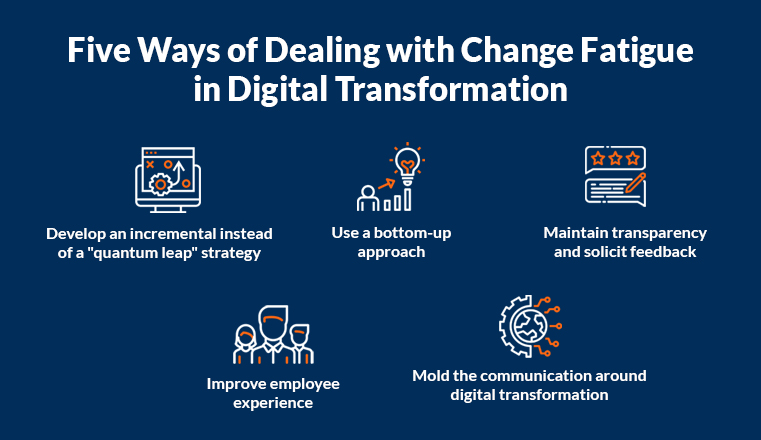Digital transformation ushers sweeping changes across the organization that guarantee success and profits. The promise comes with an assured improvement in workflows, customer experience, and growth prospects. Often, enterprises are tempted to go all-in with a significant appetite to withstand disruptions that ensue. However, one oft-overlooked aspect that tends to impede progress with any new technology is change fatigue. Most digital transformation strategies tend to overlook the human factor and that people inherently resist change.
Since the pandemic disrupted our ways of working and living, a lot has changed and changed big time. Dealing with the new normal has led to significantly lowered motivation levels across organizations. A recent Gartner survey found that 54% of HR leaders felt their employees are fatigued from all the change. According to Gartner, “change fatigue manifests in negative reactions such as employee burnout, frustration or apathy, resulting in lower engagement and productivity.” Change fatigue creeps in gradually when your teams feel overwhelmed by workflow modifications and face steep new technology learning curves.
And the most detrimental obstruction to digital transformation in any organization is passive resignation which can disintegrate teams and weaken the trust between employees and company leadership.

How do we address this challenge?
Here are five ways to keep employees motivated through your digital transformation journey and mitigate risks brought by change fatigue.

Develop an incremental instead of a “quantum leap” strategy
Usually, organizations can absorb change more effectively when it is incremental and happens over time. Sudden and massive disruption (like what we saw in 2020) can be hard to accept. So, it is safer to opt for alterations tuned to your organization’s culture and risk tolerance. On the other end of the spectrum, persistent, incremental change can put you behind your competitors. Therefore, it is essential to find the right balance and ensure that it works progressively for your company.

Use a bottom-up approach
Rather than deploying transformative practices starting at the top of the hierarchical structure, enable teams at the lower levels to fuel the changes. While it may not be feasible for you to initiate every change beginning at the entry levels, fostering a culture of shared respect and encouraging employees to take initiatives will win their trust more effectively. It is vital to treat them like responsible contributors to innovation and show confidence in their skills to address the new challenges.

Maintain transparency and solicit feedback
As digital transformation begins to impact business growth, it is imperative to float updates on what has been altered, the new changes that are expected, and the friction points (if any) in the reformed processes. Whenever managers implement a change, they should ask for their team members’ opinions—both positive and negative. While allowing employees to voice out their reviews, you can also address any queries they may have to perform better under the new system. With a focused discussion on the changes, you will also eliminate the chances of disruptions in day-to-day operations.

Improve employee experience
Considering the inputs shared by your workforce, collaborate with the HR team to plan out an engaging employee experience. Try to understand the anxieties and stress during a typical workweek. Can you use better platforms for team communication? What kind of work-life balance do your employees seek? Once you can visualize the work environment that the teams are hoping for, it becomes simpler to work backward and deploy a solution for such experiences. For example, instead of only using exit interviews that don’t help you retain an employee who has already resigned, it may be a good idea to start ‘stay interviews.’ These can be one-to-one conversations between the manager and employee to understand what matters to employees and how a company can increase its retention rate.

Mold the communication around digital transformation
An extensive project that carries multiple goals and has to be materialized within a pre-determined budget can feel intimidating. Generally, change implies the commencement of something hitherto unexplored. Instead of justifying digital transformation by business goals in corporate jargon, illustrate how the results will help the organization grow and improve everyone’s experiences. When you tailor your conversations around change as a seamless enhancement of work models, even employees who feel reluctant to give up traditional processes they are accustomed to will readily accept change, understanding its positive impact on work culture.



